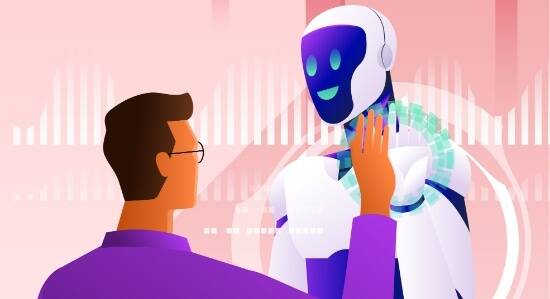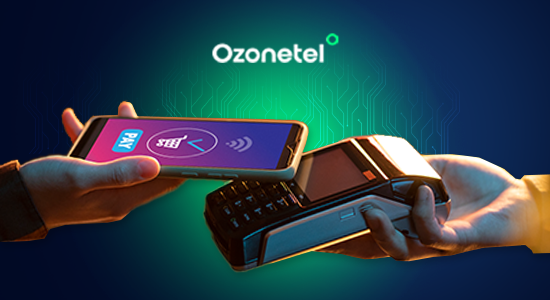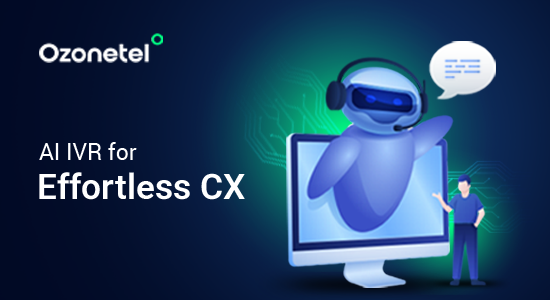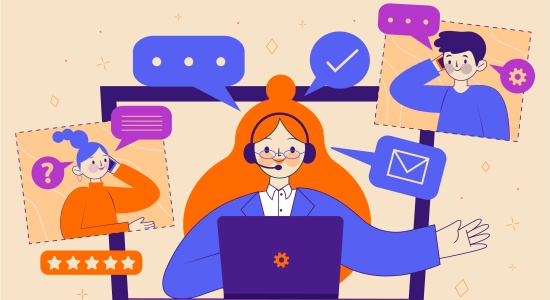- Resources
- How AI Aligns CX and EX to Improve Retention, Productivity, and Customer Satisfaction
How AI Aligns CX and EX to Improve Retention, Productivity, and Customer Satisfaction

Many companies still separate employee experience (EX) from customer experience (CX), treating them as two unrelated strategies. This often leads to missed opportunities.
The truth is, a positive employee experience doesn’t just make your team happy—it directly impacts customer outcomes. When your employees feel empowered, engaged, and are equipped with the right tools , they’re more likely to deliver experiences that build loyalty, strengthen your brand, and make measurable business impact.
In this blog, we’ll explore why aligning EX and CX is essential for business success and how you can bridge the gap effectively. Read along!
What is Employee Experience?
Employee Experience (EX) is the overall perception employees have of their journey within an organization. It encompasses every interaction and touchpoint, from recruitment and onboarding to daily responsibilities, support systems, and eventual offboarding.
Why EX and CX Need to Be Aligned
When your employees are frustrated, it shows up in how they talk to customers. If systems are broken, tools are slow, or they don’t have enough support, that pressure spills over into customer interactions, causing delays, errors, and poor service.
On the other hand, when employees feel supported, motivated, and in control, their productivity improves and so does the quality of customer interactions leading to higher CSAT scores and more positive customer experiences.
This is why EX and CX are deeply connected. Improving one always improves the other. Let’s break it down:
How Poor EX Affects CX
Poor employee experience creates friction that directly impacts customer satisfaction, speed, and consistency.
- If your agents have to switch between five different tabs just to answer one query, they’ll sound slow and distracted. That’s not a tech issue—it’s an EX issue.
- If teams are working in silos, no one has a full view of the customer journey. That leads to repeated explanations, delayed follow-ups, and missed context—all of which hurt CX.
- If there’s no room for feedback, employees feel unheard. That leads to low morale and high turnover.
What Happens When Employee Experience Improves
A great customer experience starts with a great employee experience.
- Employees know what’s expected of them and have the right tools to do their job well.
- They can resolve queries faster, personalize interactions, and make decisions without needing multiple approvals.
- You’ll see better consistency, fewer errors, and more empathy in every customer conversation.
And this isn’t just theory. According to Gallup, companies with engaged employees see 147% higher earnings per share than their competitors. Why? Because happy employees lead to loyal customers. It’s that simple.
How EX and CX Impact Each Other

The experience your team has at work directly shapes the experience your customers have with your brand. It’s a cause-and-effect relationship that plays out in every interaction—on calls, in chats, and across service touchpoints.
Let’s look at how this works in practice:
1. Happy Employees Solve Problems Faster
When your team is engaged, supported, and clear about their role, they’re quicker and more accurate. They don’t waste time switching between systems or chasing approvals. Instead, they focus on solving customer problems—and they do it with energy and empathy.
- Fewer errors: When employees aren’t distracted or burned out, they make fewer mistakes. That means customers don’t have to repeat themselves or deal with incorrect information.
- Faster response times: Motivated agents respond quicker and close tickets faster, which directly improves customer satisfaction.
- Better tone and empathy: Customers can sense when someone genuinely wants to help them. Happy agents make people feel heard, and that feeling builds .
2. Poor EX Leads to Customer Frustration
When employees are overworked, confused by clunky systems, or left out of decision-making, their performance dips, which shows up in your CX metrics.
- Increased wait times: If your systems are slow or disconnected, agents struggle to find the right answers, and customers are left waiting.
- Low accountability: If employees don’t feel empowered to make decisions, customers get bounced around or left without resolution.
- Negative tone: Frustrated agents may come across as cold or disengaged—even if they don’t mean to. That’s enough to damage trust.
3. Feedback and Learning Go Both Ways
When employee experience and customer experience are aligned, customer feedback isn’t just reviewed by leadership—it becomes a source of learning for the whole team.
- Your frontline team can use real feedback to adjust their approach.
- Managers can spot trends early, like repeat issues or friction points, and fix them quickly.
- Employees feel more connected to outcomes, which motivates them to keep improving.
4. Engaged Employees Drive Better Business Outcomes
The impact is measurable. According to Gallup, teams with high engagement levels see:
- 81% lower absenteeism
- 18% higher productivity
- Up to 23% increase in profitability
And Qualtrics research shows that companies with engaged employees have a Net Promoter Score (NPS)—a direct reflection of customer satisfaction and loyalty.
Five Real Ways to Align EX and CX

When your employee experience (EX) and customer experience (CX) are out of sync, both suffer—your teams get frustrated, and your customers feel it. But when you align them, you build a system that works better at every level. Here’s how you can build that alignment:
Consolidate Tech Stacks to Remove Silos
Disconnected systems make your teams less efficient. They waste time switching between tools, miss important customer history, and struggle to collaborate across functions.
What to do:
- Start by mapping your current tools across departments—support, sales, marketing, operations—and identify where data or workflows are siloed.
- Look for ways to centralize or integrate systems. For example, connect your helpdesk platform with your CRM (Customer Relationship Management system) so agents can access key data without switching tabs.
- Use customer experience automation to route relevant customer insights across teams. If support logs a recurring issue, product or quality teams should see it immediately.
Why it matters: When employees work from one source of truth, they don’t need to guess or chase answers. They respond faster, with more clarity, and that shows in every customer interaction.
Give Employees Full Customer Context
You can’t expect employees to handle customer requests well if they’re flying blind. Lack of visibility leads to repetitive questions, wrong assumptions, and longer resolution times.
What to do:
- Give frontline teams access to omnichannel history (past chats, calls, emails, etc.) in one place.
- Pull CRM data directly into the tools employees use daily, like showing order history in the same interface where tickets are managed.
- Prioritize usability. It’s not just about having data; it’s about making it easy to read and act on.
Why it matters: When agents know the full story, they respond with the right context. That builds customer trust, reduces repeat contacts, and improves both and satisfaction.
Interesting: Webinar on Optimize Productivity, Effort, Service by Transforming the Agent Experience
Build Real Feedback Loops from the Frontline
Frontline employees hear the customer pain points first. But unless that feedback flows back into your product or service teams, those insights go to waste.
What to do:
- Hold structured listening sessions where employees can share what they’re hearing directly with decision-makers.
- Track themes in support tickets and use them to influence updates in your product, policies, or support scripts.
- Make it a two-way loop. Let employees know which feedback was implemented and why. This reinforces that their voice matters.
Why it matters: When employees see that their feedback drives change, they feel more invested in the outcome. And when that feedback helps fix common issues, customers feel the difference, too.
Train for Efficiency and Empathy—Together
Technical knowledge helps agents use tools faster. Empathy helps them connect better with customers. But both need to be trained together because one without the other doesn’t work.
What to do:
- Blend product or tool training with scenario-based sessions where agents solve real customer problems.
- Use anonymized customer interactions in your training to show what worked and what didn’t.
- Provide continuous training, not just during onboarding. Regular refreshers help keep quality consistent.
Why it matters: When employees are trained to act with both speed and sensitivity, they reduce friction for customers and feel more confident doing their jobs. That confidence directly impacts how well they show up in every interaction.
Align Goals and Metrics Across Teams
EX and CX teams often work toward different goals—HR tracks engagement and attrition, while CX teams focus on CSAT and resolution time. Without shared objectives, collaboration breaks down and impact gets diluted.
What to do:
- Define shared KPIs that reflect both employee and customer outcomes—like CSAT, resolution time, and customer retention.
- Align performance reviews, team dashboards, and incentives around these common goals.
- Set up regular cross-functional check-ins to review progress and recalibrate based on insights.
Why it matters: When teams are aligned on what success looks like, they collaborate better, make faster decisions, and deliver more consistent experiences for both employees and customers.
The Role of AI in Aligning customer experience and employee experience

AI plays a direct and practical role in aligning employee experience with customer experience. Here’s how:
Reducing Agent Stress Through Real-Time Assistance
like Agent Assist act as a second brain for your frontline teams. Instead of searching for answers or escalating every non-standard issue, agents get real-time suggestions during live interactions.
What this looks like:
- As soon as a customer mentions a problem, AI pulls up relevant knowledge base articles or recommended next steps, no manual searching needed.
- Based on customer history and sentiment, AI can suggest language that helps de-escalate or personalize the response.
- For new or less experienced agents, it acts as live training, guiding them in the moment rather than relying on post-call coaching.
Eliminating Manual Work That Drains Productivity
Much of an agent’s time goes into post-call admin: writing summaries, tagging tickets, logging case types. AI handles this without slowing down after-call work (ACW), freeing agents to focus on more high-impact tasks.
How does this help your teams?
- Auto-generated call summaries mean your agents don’t have to recall every detail and type it out manually.
- AI tags tickets consistently and instantly, so downstream reporting is more accurate and doesn’t depend on subjective labeling.
- Agents get to spend more time helping customers rather than doing admin work that offers them no real value.
Elevating Call Quality with AI-Powered Quality Assurance
Traditional QA methods only cover a small fraction of interactions, making it hard to catch trends or coach effectively. With Ozonetel’s AI-powered customer service quality assurance, 100% of calls can be evaluated automatically—ensuring consistent service quality without adding manual overhead.
How this enhances both EX and CX:
- AI listens to every call and scores it based on predefined parameters like tone, compliance, empathy, and resolution accuracy.
- Managers get a prioritized view of which calls need review, saving time and allowing for targeted coaching.
- Agents receive timely, data-backed feedback that improves performance and reduces anxiety around random QA checks.
Supporting Managers with Smarter Coaching Insights
Managers often struggle to spot patterns across dozens—or hundreds—of interactions. AI analytics break down those interactions and flag areas for improvement, coaching, or praise.
Examples:
- AI can flag recurring issues in agent conversations, like knowledge gaps or process confusion.
- It can track sentiment trends over time to see where interactions start to go off track.
- You can set up alerts for specific triggers (like compliance risks or long silences) that would be hard to catch manually.
Capturing the Pulse of Customers with VoC Insights
AI doesn’t just support agents—it brings the Voice of the Customer directly into decision-making. By analyzing emotion, intent, and journey friction in real time, teams can respond faster and personalize better.
How VoC intelligence bridges CX and EX:
- Detects real-time emotional shifts and behavioral patterns in customer interactions.
- Enables proactive experience design—adjusting scripts, flows, or processes based on actual voice data.
- Gives agents and teams a shared view of what customers actually feel—not just what they say in surveys.
Enabling Smarter, Cross-Functional Team Collaboration
In many organizations, siloed communication and disconnected workflows limit both speed and service quality. AI bridges communication gaps between departments, ensuring alignment on goals, insights, and actions for cohesive performance.
- \ AI centralizes customer data using customer data platform, enabling shared visibility across sales, support, and product teams.
- Automated workflows help different teams respond faster and stay in sync on customer issues.
- Insights from interactions fuel both service improvements and employee training opportunities.
Challenges in Integrating CX and EX
You might have strong CX initiatives driven by marketing and equally solid EX efforts run by HR, but they don’t speak to each other. That disconnect slows everything down—your people get stuck with disjointed systems, and your customers feel the impact.
The deeper issue is not a lack of intent but how these functions operate in isolation, with different goals, tools, and ownership models. Here are the key challenges that keep CX and EX from working in sync—and how they show up in real situations:
Siloed Ownership Between Teams
In most companies, CX is owned by marketing, customer service, or product, while EX is driven by HR or internal communications. These teams rarely align their priorities or planning cycles.
Why is this a problem?
- Marketing might focus on customer sentiment, while HR looks at employee satisfaction. But without connecting the two, you miss how employee pain points directly affect customer outcomes.
- Each team runs its own tech stack, tracks different metrics, and uses different vocabulary, making collaboration even harder.
- No one owns the middle ground where CX and EX overlap—like agent tools, training, internal feedback systems, or customer communication flows.
Lack of Shared KPIs Across Functions
HR may measure EX with engagement surveys and attrition rates. CX teams may focus on CSAT (Customer Satisfaction), NPS (Net Promoter Score), and ticket resolution time. But without shared metrics, there’s no accountability to connect the two.
Why is this a problem?
- Teams don’t know how their work affects one another. For example, customer service might not know if poor onboarding is hurting employee performance, and HR might not see how churn impacts CSAT scores.
- Investments get made in isolation. You might spend on customer-facing tools without improving the agent interface, leading to more internal frustration.
Resistance to New Tools from Overburdened Teams
Introducing new tools to improve CX or EX often feels like “just one more thing” for teams already juggling tickets, dashboards, and deadlines.
Why is this a problem?
- Employees won’t adopt new systems if they don’t see immediate value, or if they’re already stretched thin.
- Poor rollout leads to patchy usage. For instance, if your support team ignores a new knowledge base tool because it’s hard to search or slow to load, it won’t impact CX.
- IT teams often focus on features, not usability. And if the interface slows employees down, customer experience gets worse, not better.
What Happens When EX and CX Work Together

When employee experience and customer experience align, you don’t just get incremental improvements—you build a system that works better for everyone involved. The outcomes go beyond smoother processes; they shape how your business runs, how your brand is perceived, and how consistently you deliver quality at scale.
Here’s what changes when EX and CX work in sync:
Faster and More Consistent Resolution Rates
When employees have what they need—context, training, and the right tools—they resolve customer issues faster. And they don’t need to escalate as often.
Why this matters:
- You reduce average handle time, which means more customers get support without long waits.
- Your team becomes more confident in handling complex requests because they’ve been trained not just in tools but in context and judgment.
- Fewer escalations free up senior staff and allow them to focus on process improvement instead of firefighting.
Better CSAT and NPS Scores
When agents have the context, clarity, and confidence to respond quickly and effectively, it shows in their CSAT and NPS scores.
Why does this happen?
- Customers don’t have to repeat themselves across channels.
- Agents solve issues faster and more accurately.
- Responses feel more personal because employees aren’t just following a script—they actually understand the customer journey.
Lower Agent Churn and Training Costs
Poor EX leads to high turnover, and replacing agents isn’t cheap. From hiring to onboarding to ramp-up time, it adds up. When you improve EX through better tools, support, and autonomy, you retain talent longer and reduce churn.
How this translates to ROI:
- Lower attrition means fewer hiring cycles and onboarding costs.
- Teams get more experienced over time, which improves customer handling and reduces errors.
- You don’t lose productivity during constant turnover.
Improved Productivity Through Better Collaboration
When systems are unified and insights flow freely between teams, collaboration becomes second nature. Employees no longer operate in silos—they coordinate, share context, and support each other to drive outcomes faster and more effectively.
What drives this shift:
- Unified platforms connect departments, allowing real-time visibility into customer interactions and internal actions.
- AI automates routine tasks, freeing up time for employees to focus on complex, collaborative problem-solving.
- Shared dashboards and alerts keep teams aligned on priorities, status updates, and handoffs.
Higher Conversion and Retention Rates
Customer loyalty grows when every interaction feels consistent, helpful, and respectful of their time. When EX supports CX at every level, customers don’t just stay—they’re more likely to buy again and recommend you.
How EX directly impacts this:
- Empowered employees are more likely to spot upsell or cross-sell opportunities naturally.
- Less frustrated staff means fewer errors that lead to churn.
- Consistency across service, sales, and support improves trust and confidence in your brand.
How Ozonetel Powers EX-CX Alignment
When your agents are empowered and efficient, your customers receive better experiences. Ozonetel’s unified oneCXi platform creates this powerful connection between employee experience and customer experience, driving better outcomes for both groups. Some key features are:
- Complete customer history and context: Agents can see all customer interactions in one place.
- Omnichannel support: Handle voice, chat, email, and social media interactions from the same interface.
Seamless workflows: Integration with CRMs like LeadSquared and SugarCRM streamlines processes, reducing the need for agents to switch tools. - Smart routing: Direct customers to the agent best equipped to handle their needs, based on skills and availability.
- Complete context with every interaction: Agents are always armed with the full customer profile, ensuring no information is lost.
- Seamless conversation transfers: Conversations move smoothly between channels, even when customers switch devices, ensuring consistency.
Conclusion
Exceptional customer experiences start with empowered employees. When your teams have the right tools, clear context, and the confidence to act, they don’t just perform better—they create meaningful, consistent experiences that customers remember.
Ready to align your EX and CX? Book a demo with Ozonetel and see how it drives meaningful ROI.
Frequently Asked Questions
Start by collecting information through interviews, surveys, support tickets, and website analytics. Identify patterns in goals, pain points, behavior, and preferences. Group similar responses into segments, then build a detailed profile for each one, including demographics, buying triggers, objections, and content preferences.
Personas help you target the right people with the right message. Instead of broad campaigns, you can focus on what each segment actually cares about, which improves engagement, lowers acquisition costs, and increases conversions. They also help you avoid generic content that doesn’t lead to action.







